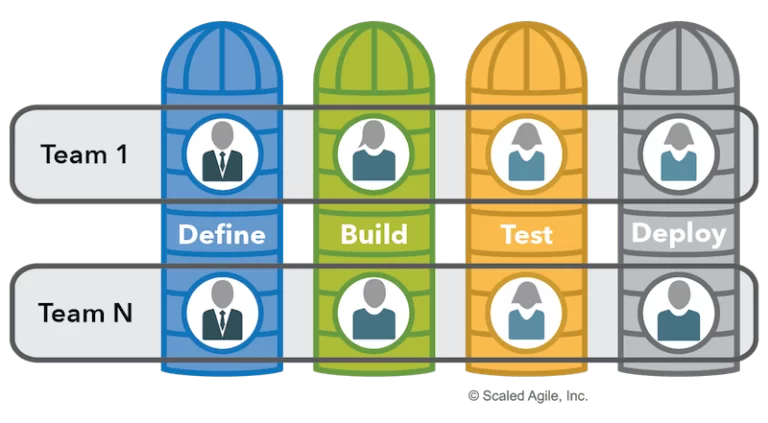AI/ML
What is a Cross-Functional Agile Team? 8 Benefits of Hiring One
In today’s competitive era, businesses must become more nimble than ever before.
For instance, digital transformation requires organizations to adapt to change more rapidly. However, the pandemic emphasized the necessity to transform for an even more extreme degree of agility.
Without the proper change management mindset and cross-functional agile teams, becoming agile is nearly impossible. When an organization becomes agile, it benefits both the business, its employees, and its customers.
What are Cross-Functional Agile Teams?
A cross-functional agile team is a group of five to eleven cross-functional individuals who perform the phases of defining, developing, testing and delivering value in a short time period.
Because team size negatively affects communication quality, agile organizations favor smaller teams. For example, two five-member teams are generally preferable to one ten-member team.

Traditionally, with waterfall, stakeholders create requirements that are then passed on to different teams to complete throughout the project timeline, causing information silos, reducing flexibility, and often resulting in more expensive solutions. Agile Cross-functional teams avoid these problems by working together from the very beginning of the project.
However, solution delivery with the agile framework in place requires a broad range of expertise. Technical teams can create, test, and, if applicable, deploy a solution element. But in order to do that, the scrum team requires guidance. This is where the two speciality roles of cross-functional agile team definition come into play.
Speciality Roles in a Cross-Functional Agile Team
Every agile cross functional team includes a product owner and a scrum master that guides the team throughout the development process.
Product Owner
As the name suggests, product owners are responsible for driving the development of a product. This person prioritizes product requirements, team backlog, and features in order to maximize return on investment. The product owner assesses the product based on how well it satisfies the end goals.
Scrum Master
The scrum lead focuses on the team and project timeline rather than the product itself. This person does not manage the team; rather, they assist it by removing barriers and safeguarding the team from outside interference. The scrum lead tends to be an expert in agile development and uses that knowledge to guide the team, product owner, and even the company as a whole.
The rest of the scrum team is made up of everyone necessary to get the job done. In a traditional agile development team, software engineers, architects, programmers, analysts, system administrators, QA experts, and testers would all be present.
However, with the WebOps approach, marketers, designers, content specialists, and business stakeholders might also be present, in addition to those same people.
The structure and methods of operations make cross-functional agile teams different from other development approaches.
But what benefits can CTOs and businesses, in general, expect from these teams?
Need an expert cross functional agile team to develop your product?
Contact Us Nowwhat are two ways to define a cross-functional agile team
A cross-functional agile team is a group of individuals from different departments or disciplines working together to achieve a common goal or deliver a specific project. Here are two ways to describe such a team:
1. Multi-disciplinary team: A cross-functional agile team structure comprises individuals from different disciplines or functional areas within an organization. These individuals bring diverse skills and perspectives to the team, allowing for a holistic approach to problem-solving and decision-making. For example, a cross-functional agile team working on a software development project may include developers, testers, designers, and product managers.
2. Self-organizing team: An agile cross functional team is also a self-organizing team, meaning that team members work together to determine how best to achieve their goals. This includes dividing work among team members, making decisions collectively, and holding each other accountable for meeting their commitments. Self-organizing teams are empowered to make decisions and take action without constant supervision, which can lead to increased productivity and creativity.
Benefits of Cross-Functional Agile Teams
Organizations can benefit from cross-functional agile teams structure in the following ways:
1. Cross-functional agile teams help increase employee morale
In this digital world, software companies aren’t the only ones producing technology-powered products and solutions. In fact, there’s a growing realization that software is driving everything. This software-first mentality comes with the realization that a company’s applications should serve as a vehicle for accomplishing the organization’s goals.
Historically, there has been a disconnect between business and IT, resulting in many applications that didn’t meet business requirements. Conversely, application developers didn’t understand the business context in which they were working.
With agile in place, it is becoming common for organizations to transition from a project-based approach to a product-based approach.
In the project-based approach, teams are assembled for a specific project and then disbanded once the job is finished. In a product-based approach, the team is responsible for the entire product life cycle.
As a result, for example, there is no opportunity to just do one’s own tiny part, such as coding software and then sending it to testing and operating. Product owners are being positioned at the center of the universe in company groups organized into pods.
Hence, within agile cross functional team, people are now accountable and have ownership of their work. All of this improves employee morale.
2. Cross-functional agile teams accelerate value delivery
Slow value delivery is caused by the Waterfall methodology’s reliance on silos and handoffs. Each team member is responsible for an aspect of a project like testing software, where none of the team members have visibility into what the others are doing. While the different functions may work to improve their own productivity, overall productivity is not as boosted.
Companies that grasp the importance of working across the organization can now deliver value faster by shifting to cross-functional agile teams. Experts believe that if implemented the right way, where the organization has the right leadership clarity and alignment, they get better and faster outcomes and better employee experience.
3. Cross-functional agile teams structure improve productivity
Many employees spend a lot of time in meetings, and most of them blame meetings for their unproductivity. In fact, a survey conducted by Harvard Business Review of senior managers in a variety of sectors revealed the following:
- 71% of the respondents said that meetings are inefficient
- 65% claimed that meetings keep them from completing their own work
In contrast, the cross-functional agile team structure are aligned on goals and objectives, they do not waste time in meetings. They do not need long meetings to resolve disputes among stakeholders or to update the status of the project since they are already aligned.
In an agile setup, meetings, in general, are brief and productive—for example, daily scrum meetings are often restricted to just 15 minutes rather than the common one-hour duration.
4. Agile Cross-functional teams iterate faster
Since agile cross-functional teams don’t need to coordinate with other teams and divisions within the company, they can iterate faster.
For example, if an agile cross-functional development team is developing a web application for marketing automation, they may quickly create and test various facets of the development phase. Having designers, developers, and quality analysts all working on the same team allows them to create each version faster than they would if they required individuals from various teams.
5. Cross-functional agile teams ensure product – business strategy alignment
Developing a technology solution or product has to align with the business strategy. Failure from the development or the implementation side will ultimately result in project failure. And that’s no good for anyone.
In such cases, the cross-functional attribute of agile teams comes to the rescue.
The biggest advantage of a cross-functional team is being able to cross-train without any extra effort. Businesspeople become more tech-savvy, and the technology side finally realizes the business importance.
Lets build your tech team with us, to put you on the road of success
Lets get started6. Cross-functional agile teams structure facilitate faster changer adoption
The speed at which business is conducted continues to increase, and organizations must adapt faster to changing circumstances. Because of its global and systemic nature, no force has been more dramatic than the pandemic.
Cross-functional agile teams structure allow for more frequent communication and cooperation between team members, as well as an iterative problem-solving approach that allows the organization as a whole to change course more quickly.
7. Agile Cross-functional teams develop effective risk management approach
Often it has been seen that projects are less likely to fail with agile cross-functional teams. There is no circumstance in which you build a large software or feature that fails miserably.
You always know how your product development is doing thanks to its incremental development approach, and you can change direction if you do not get the results you want.
Because of iteration, you have a team that can efficiently address issues as they arise, whether it be a copy that does not convert or a code bug, you can fix them quickly and without wasting resources.
8. Cross-functional agile teams create a culture of innovation
A waterfall approach to project development often prevents creativity and innovation. When team members focus on their individual areas of expertise throughout the project timeline, the product suffers.
In contrast, working on a project with people with different skill sets often leads to different approaches to problems.
For example, a quality analyst may have some suggestions that could improve the user experience of a page, but if they are not asked at the right time, their ideas may be missed. Likewise, a developer might know that a ready-to-go template could be used to test an iteration and save time that might be better used exploring fresh ideas for how to use it.
9. Cross-functional agile teams help you place customers first
Cross-functional teams help speed up inefficient operational operations. This allows them to achieve a solution quickly and keep their clients satisfied.
These teams structure themselves on the improvement of the customer experience. Good cross-team communication facilitates the delivery of a particular customer intent, activity, or value stream. A customized and cohesive customer experience is the result.
10. Cross-functional agile team definition handle conflict resolution constructively
Diversity can create tensions. When individuals with diverse backgrounds, disciplines, and skill set work toward a shared goal, they naturally have divergent viewpoints. Each team member will likely bring opposing methods and diverse work styles. The greatest option is to equip your staff with conflict resolution strategies.
Your project managers and team leaders should develop teams’ governing documents. They should develop a perfect decision-making procedure. They must also ensure the team’s vitality, continuous communication, and adaptability.
11. Cross-functional agile teams enjoy reduced cycle times
Agile Cross-functional team definition helps discovering inefficiencies and enhancing solutions. They can decrease the cycle time for recurrent pain locations. One of the primary advantages of cross-functional team struture is their solution-oriented mentality instead of their functional mentality.
12. Cross-functional agile teams promote flexibility
Cross-functional teams provide an environment conducive to creative, free-flowing ideas and inventive thinking, as previously addressed here. Because this is a diverse team, each member must approach the situation with an open mind and willingness to compromise. They must be willing to acknowledge, value, and benefit from the observations and recommendations of others.
You should never give anyone on the team permission to think in a limited way since doing so will stifle innovation. Flexible communication and collaboration are essential components of every successful cross-functional team.
13. Cross-functional agile teams have greater accountability
As discussed in the previous point, cross-functional teams are held accountable for the tasks they are responsible for. They will have a higher level of accountability because each individual will be liable for the duties and obligations assigned to them.
Because every team member is dependent on his or her fellow players, having a system of accountability is absolutely necessary. It is hardly surprising that they will willingly feel obligated to keep their promises.
Cross-Functional Agile Teams are Collaborated and Productive
A team consisting of diverse, cross-functional individuals is more enthusiastic, dedicated, and passionate about their work. Because they feel a true sense of ownership over their work, they are more committed and more knowledgeable about what they do.
Of course, the benefits realized with cross-functional agile teams are promising. And as agile becomes more and more popular across the technology world, we’re expected to see more collaborative development teams.




